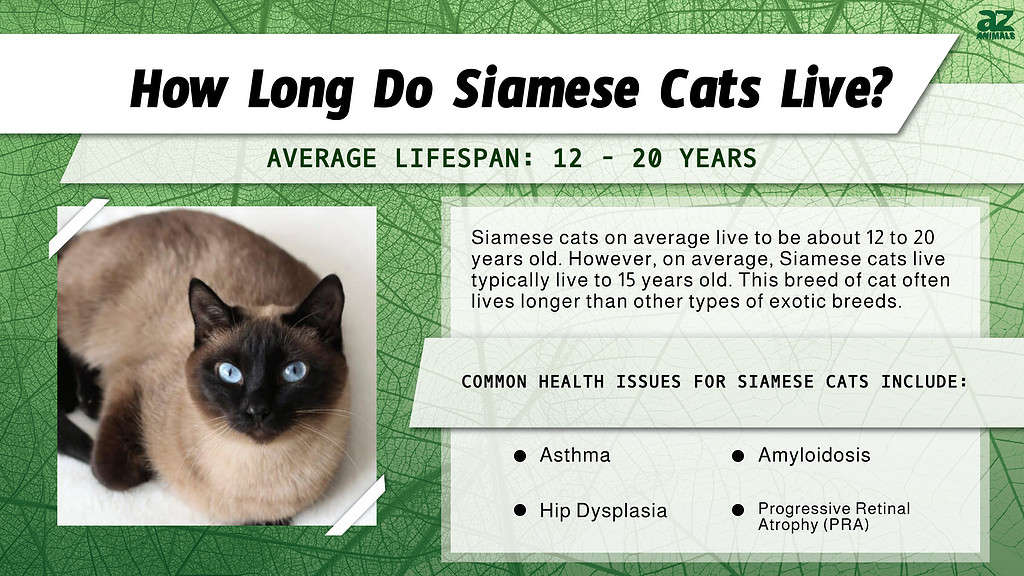
The Siamese cat is a beloved pet breed, especially in North America. It makes absolute sense when considering that these cats are friendly, clever, and absolutely gorgeous. They also happen to be the world’s oldest domesticated cats!
The breed originated in Thailand (formerly known as Siam) in the 14th century, but it didn’t arrive in the United States until the 19th century. Siamese cats are renowned for their sleek, unique look. Their beautiful blue eyes and slender bodies are difficult to confuse with any other cat breed.
However, Siamese cats are much more than their enigmatic beauty. Interested in learning more? Let’s find out all about the Siamese cat lifespan and what you can do to keep your cat healthy and strong!
How Long Do Siamese Cats Live?

Siamese cats are one of the longest-living cats. They can live up to 20 years.
©Linalyan/Shutterstock.com
On average, Siamese cats live 15 years. These cats often have longer lives than some of the other exotic breeds. Even though all Siamese cats have a very long life, it varies significantly based on their gender. Female Siamese cats have an average lifespan of 12 to 20 years, while male Siamese cats have an average lifespan of 15-20 years.
Siamese Scooter was the world’s oldest Siamese male cat, having died at the age of 30. He was once designated the world’s oldest living cat in the Guinness Book of World Records.
Siamese cats share the tough genes that allow them to live so long alongside their Balinese and Burmese relatives. These two breeds are also among the longest-living cats, with many living to the age of 20 years or more.
Now that we’ve covered the Siamese cat lifespan, let’s look at their life phases cycle.
The Average Siamese Cat Life Cycle
After learning all about the Siamese cat, you’re probably wondering what to anticipate when your tiny Siamese kitten matures into a full-fledged adult cat. The timeline below shows what you may expect at each Siamese cat’s life stage.
Kitten
The Siamese cat’s kitten stage is similar to many other cat breeds. They have many of the adorable features that other kittens have as well. Their ears are curled, and they cannot see yet when they are first born. Siamese kittens are born white, but tiny traces of their adult coloring will emerge at the end of the first week. However, unlike most other cat breeds, their beautiful blue eyes will stay as they age.
Adolescence
After six months, you’ll notice that these cats are much more energetic and can move around more easily. Since they are not quite adults yet but are out of their kitten stage, they are at a curious transition stage. During this transition stage, the cats will develop new needs for physical activity, mental stimulation, and territory. Mental stimulation and play are important throughout this stage of the cat’s life. Interactive play should be done regularly since it consumes energy and helps to reduce some undesirable behavior.
Adulthood
The Siamese cat matures at a gradual pace. It reaches sexual maturity at six months of life but does not attain full height and weight until one year of age. The adult Siamese will have ceased physically growing, but it will still be learning. It will most likely display kitten-like traits and activity during the first two years of life but will become calmer as it matures.
Factors That Threaten The Siamese Cat’s Lifespan

Siamese cats’ coat color is reported to be directly determined by the warmth of their bodies’ skin.
©vvvita/Shutterstock.com
Although Siamese cats have a longer lifespan than many other cats and even dogs, they’re not impervious to factors that may threaten their lifespan. Several factors are responsible for shortening the Siamese cat’s lifespan. Being aware of these factors can help when taking care of your pet Siamese cat!
These factors include:
- Managing stress levels: Siamese cats, in particular, are extremely sensitive to stress. When their human companions aren’t around, they might grow nervous or restless. This can lead to disruptive habits like paper shredding, vocalization, or litter box amnesia. Some cats may even get hostile when they realize their owners are going to depart.
- Health issues: Siamese cats are known to be prone to a range of health issues. The most prevalent health issue is progressive retinal atrophy. This breed’s health problems also include gastrointestinal and neoplastic difficulties, urinary tract illness, and gum disease.
- Indoor vs. Outdoor: An indoor cat’s life expectancy will be different from that of an outdoor cat. Outdoor cats face greater dangers than indoor cats. A cat’s life expectancy can be shortened by cars, animals, catfights, and the weather. However, indoor cats are not vulnerable to many hazards.
How To Extend The Life Of Your Pet Siamese Cat

Siamese cats are more sociable than most cats, which causes them to seek attention.
©Mariya Zimarina/Shutterstock.com
Cat owners will go to nearly any length to extend the lives of their feline companions. However, we must recognize that various extrinsic circumstances and genetics still determine their longevity. There are a few ways to extend the life of your Siamese cat.
These ways include:
- Feeding them high-quality food: A nutritious diet is crucial for your Siamese cat. A poor diet is one of the most prevalent causes of health issues in cats. Make sure to feed them a high-protein diet that has lots of vitamins and minerals. You can feed them both dry and wet food as both have nutritious value.
- Keeping them company: Siamese cats, in particular, are vulnerable to loneliness and, as a result, melancholy. They become bored fast and require more care than other cats. Set aside at least 60 to 90 minutes every day to spend with your Siamese. This can include cuddling or playing with them.
- Regular vet checkups: Ensure that your Siamese receives the appropriate vaccines and that they are kept up to date. Plan yearly checkups for your pet. This aids in the detection of possible problems and the provision of preventive care.
The photo featured at the top of this post is © Voraorn Ratanakorn/Shutterstock.com
Thank you for reading! Have some feedback for us? Contact the AZ Animals editorial team.






